1967 Canadian Grand Prix report: Brabham again supreme
The Brabham F1 team takes its second consecutive 1-2, this time with team owner Jack leading home Denny Hulme
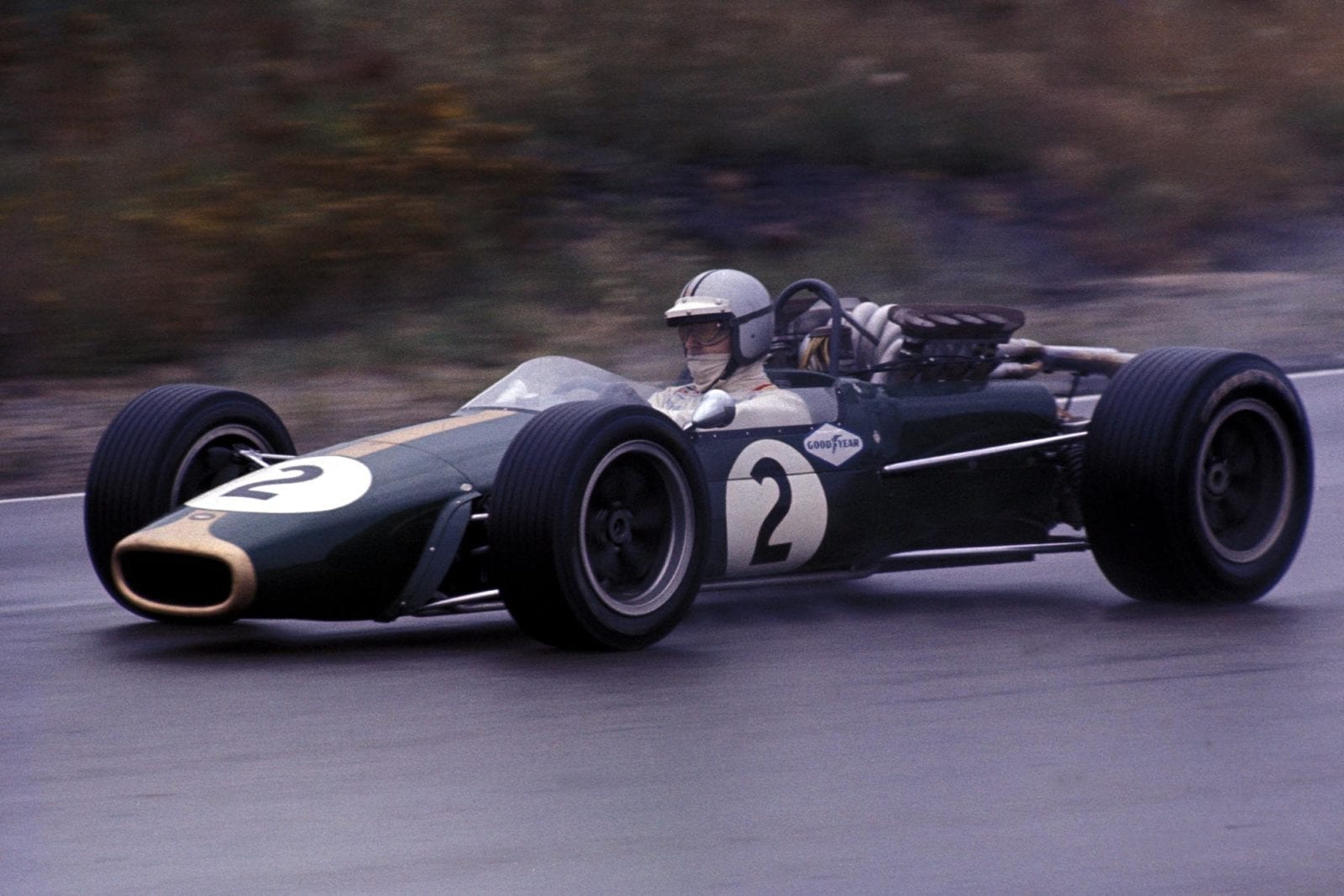
Jack Brabham took his second win of the season
Motorsport Images
As part of the celebrations for the Canadian Centennial Year, the FIA sanctioned a Formula One race to take place on the 3.956km. Mosport circuit just outside Toronto. The Canadian Grand Prix looks as if for the time being it may be just a “one-off” race for it is not included in next year’s calendar.
Sandwiched as it was between the German and Italian classics, this race created travel problems and threw the expense of transporting the Grand Prix circus firmly on to the shoulders of the Canadian Racing Drivers’ Association and the Imperial Tobacco Company.
Eighteen cars were entered. Brabham had BT24/1 and 2 for Brabham and Hulme, neither car being any different from the recent victory at the Nurburgring.
Team Lotus brought their three 495, Nos 1, 2 and 3. Since the retirements in Germany certain minor modifications had been made. Extra filters were included in the fuel system to cut down the misfiring due to dirty fuel. The front suspension rocker arms are now made from heavier gauge metal and, other than the modifications to the rear top link mounting point described last month, an Allen screw has been threaded into the bracket to stop the main bolt loosening.
Clark was using his usual car, 49/2, while Hill had the choice of 49/1 or 49/3; whichever he did not want would be used by E Wietzes, a local driver who knows the circuit well but who had not handled anything more powerful than a GT40.
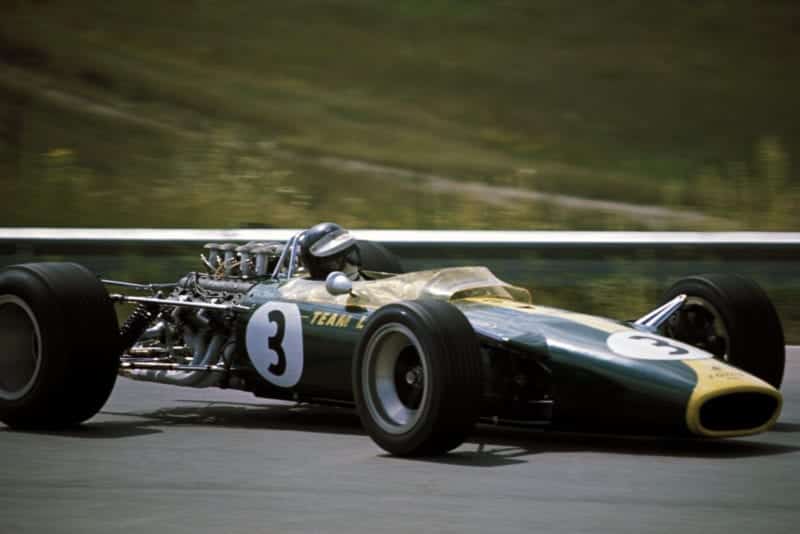
Lotus made several adjustments to Clark’s (above) and Hill’s cars, in an effort to cure reliability issues
Motorsport Images
Two works Coopers were to be driven by Rindt and Attwood, who was standing in for this race in place of Rodriguez who is still in hospital after his Enna F2 crash. The new lightweight car had been left at home being prepared for Monza, so Rindt used Rodriguez’s car Ft-6-66, while Attwood used the aluminium car Ft-1-67 that Rindt has used this year.
BRM had three works H16 cars for Stewart, Spence and Irwin, the last named being entered and looked after by Parnell. Stewart was using the slimmer, lighter car 1151, while Spence had 8302, which he used at the Nurburgring. Irwin had 8303 which had been the spare in Germany. For a change, there were only Goodyear tyres in the BRM pit, so there would be none of the new game of “musical tyres.”
The Eagle team was back to one car for Gurney. This was the Monaco aluminium chassis 103, with all the titanium hits from the magnesium chassis 104. Which is having an overhaul for the end-of season races. The engine (5805) was the one used at Nurburgring and the spare (5804) was McLaren’s German race engine. Since Gurney’s trouble in Germany new stronger drive-shafts had been fitted.
Ferrari had only one car for Amon. This was the same as he raced last—No 0005—and still with the three-valve-light alloy engine, which has brought the weight down to a claimed 1,157lb.
Last of the factory cars, and a brand new car at that, was the new F1 McLaren. This new chassis is a stronger version of the well-tested F2 cars and has installed the first of the new V12 BRM engines. This 60deg unit is giving 360bhp at 10,000 revs. The two camshafts per bank of cylinders are chain driven from the front and operate two valves per cylinder. Lucas transistorised ignition is used, also Lucas fuel injection, the injectors squirting ” upstream ” from just below the throttle slides. The metering unit is belt-driven at the front of the right-hand cam drive, while on the left-hand bank is the distributor. The engine has no place at the moment for a mechanical fuel pump drive so McLaren has fitted one to the back of the Hewland gearbox; as this pump will not work on the start line with the clutch depressed, there is an electric pump mounted on the side of the gearbox, to cover initial starting and waiting at the start line.
The whole car, finished in McLaren red, is neat and compact, the engine not taking up much space. The rest of the field consisted of private owners. Bonnier had his Cooper there, as did Rob Walker for Siffert. David Hobbs was driving Bernard White’s BRM V8, which should have been a V12 but for a slight mix-up. Then came the locals. A Pease had bought Gurney’s 2.7-litre Eagle-Climax No 101 and was having his first outing.
M Fisher had bought Lotus 33 R11 which was used by Hill in Monaco this year, and he had with it a 1.9-litre BRM engine. He was another club driver who had never driven this type of car before, or run in a race of this type. Last came T Jones, an almost unknown driver who had bought a Cooper F2 chassis (F2-2-66) into which had been fitted a Climax 2-litre V8 engine.
Qualifying
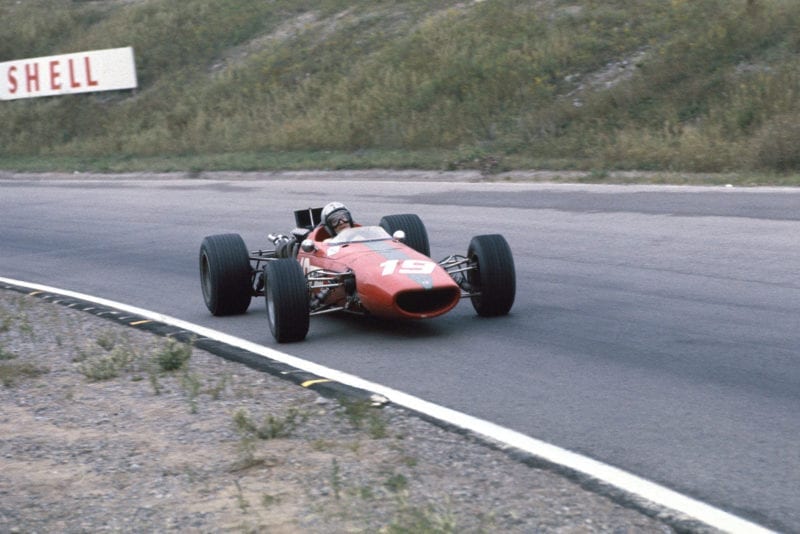
McLaren was racing his new M5A car
Motorsport Images
So with this varied field practice got under way. With unofficial practice on Thursday afternoon, Friday and Saturday morning, and official timed practice on Friday and Saturday afternoon, everyone had plenty of time to learn and set up the cars properly. The cars were all in a long tent where all the work was done, making the “Grand Prix Circus” live up to its name.
On Thursday ten cars went out to familiarise themselves with the course and see if they could get near Gurney’s record in the Lola T70 of 1min 23.1sec (171.466kph) or the fast practice lap by Hall’s Chaparral of 1min 22.9 sec. Gurney, Clark and Amon were the fastest, with the Eagle doing a 1min 23.6sec and Clark and Amon not quite breaking 1min 24sec.
Clark was using the oldest Lotus and the one that Wietzes was expected to use. As he went into the first corner past the pits, the tail swung wide and he spun in the middle of the road at about 120mph. Just as the car was stopping it ran backwards up the grass bank. Clark fished around for a gear and looked as if he was going on; then he cut the engine and climbed out for, although there had been no hard jolt, the right-hand rear radius arms were both buckled, the top one slightly, and the lower one bent at right angles, with the rose joint snapped at the wheel. As the lower radius arm had given way the overload on the monocoque mounting had been enough to ripple the skin of the monocoque.
This brought an end to the unofficial practice, and Lotus mechanics started work to repair the damage before the next morning. Unofficial Friday practice was used by most ears to complete mixture and suspension settings.
The official afternoon session started with Rindt going out first and returning to the pits a lap later with fuel pouring from the right hand pontoon. The starter ring had shattered again and the pieces had flown off like shells. One piece had entered the pontoon, gone through the fuel bag and out of the side, leaving a hole that could easily have been made by a small shell.
Clark was lapping consistently under 24s and as Firestone had not got the exact mix, tread or profile that he required, Goodyear tyres were fitted, and in this first timed session Clark set the fastest lap of 1min 22.9sec while tyre testing. In the other Lotus, Hill was not very happy, partly because he had a touch of flu, but also because the car was not set up quite to his liking.
The BRMs were having all sorts of problems. The engine in Stewart’s car was not running cleanly, nor was it opening up coming out, of corners. Going into corners the car was juddering badly under braking and, judging from the number of times the suspension settings were changed, it was difficult to set up the car for this tricky circuit.
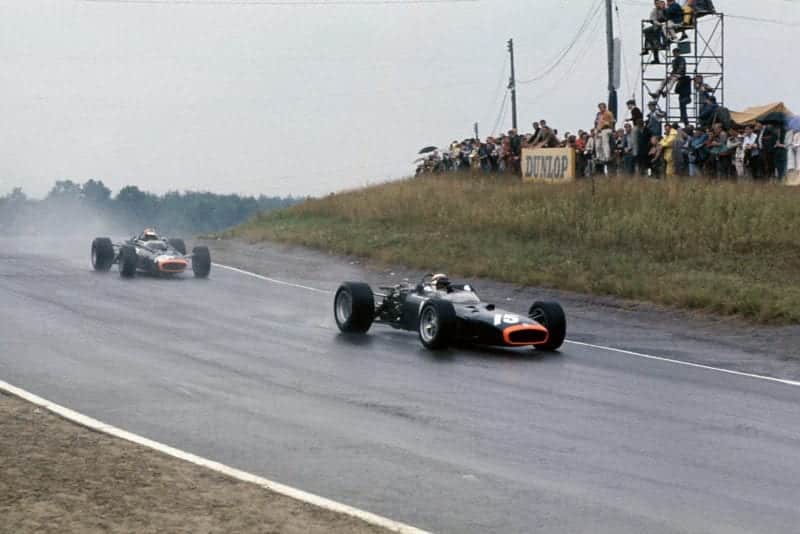
The BRMs were having various reliability problems
Motorsport Images
Amon was not going as well as he did in the unofficial practice the day before and although he did a lot of lap’s, changing suspension Settings after each outing, he was unable to get the Ferrari under 1min 24sec. Also in trouble was Gurney, for the Weslake engine had gone very flat and he did not get below 1min 25sec.
The McLaren-BRM was having mixture problems and McLaren thought his oil temperature was running too high. However, after doing only 13 laps he was down to 1min 24sec and felt there was a lot more to come. Hulme’s Brabham was going well and he was second fastest with a time of 1min 23.6sec. Brabham’s car, however, was not going properly and was smoking quite a lot.
“Brabham’s car was not going properly and was smoking quite a lot”
On Saturday morning there was an unofficial practice again and another American entry turned up. He was Tom Jones of Ohio and his car was a Cooper-Climax V8. This was only the second time he had ever driven a rear-engined car, the first being at the Watkins Glen meeting a week earlier.
Hulme was soon being given times of under 1min 24sec, and so he packed up until the afternoon session. Brabham was not going very well and the oil smoke got worse and worse, until he came in with oil all over the back of the car and the catch tank full. As either a piston or ring had broken it was decided to change the engine, which gave just three hours to do this before official practice.
Wietzes was out acclimatising himself and lapping very slowly in Lotus 49/1. Stewart was still not happy and the engine was not right, so the mixture cams were changed, but it still would not pull cleanly.
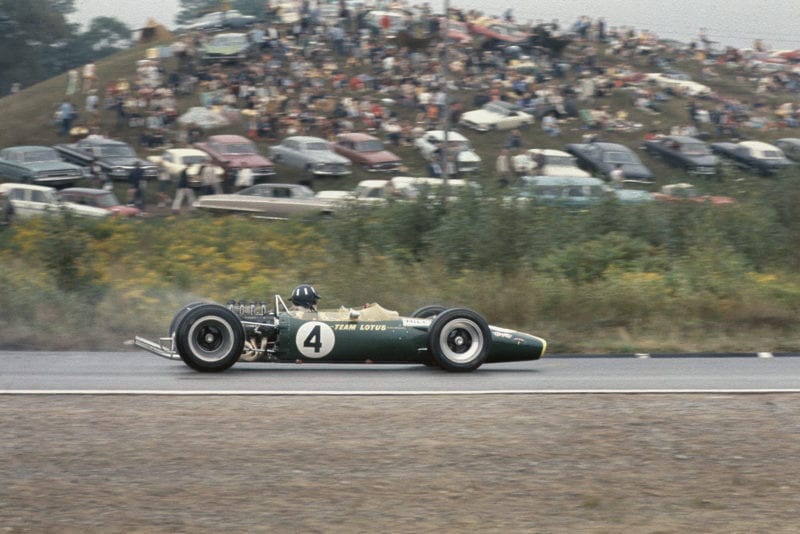
Hill was experimenting with both Goodyear and Firestone tyres
Motorsport Images
The other two BRMs now seemed to be running as well as they were going to. Ferrari fitted Firestone tyres with a lower profile which altered the gear ratio so the gearbox was changed, and then Amon had difficulty selecting 3rd gear. Also having gear trouble was Rindt, who with his new engine in was finding the gearbox very stiff.
Graham Hill went out for some laps on Goodyears and expressed enthusiasm for them, saying they had more latitude and did not give the feeling of driving on a knife edge. However, Firestones had the right tyres by now and when the official practice started both Lotuses were on Firestones. Both Lotuses were going perfectly by now and Clark did 1min 22.4sec, with Hill only three-tenths behind.
As the Lotus drivers were the only ones under 1min 23sec it looked as though the Canadian GP could be a walk-over. Amon, with the right ratios, got down to 1min 23.3sec, but Gurney broke the belt which drives the metering unit and as this was the second to go in only a few hours and the engine was not pulling well, it was decided to change it and fit 5804.
Stewart’s BRM was still not going well and it was still misfiring. After practice a loose wire was found in the electrical system, and it was hoped that fixing this would cure the trouble. McLaren, although still not satisfied, was going quicker and got a time of sixth fastest on this first outing.
“McLaren, although still not satisfied, was going quicker and got a time of sixth fastest on this first outing”
Brabham came out to run in his new engine, only half an hour late, which was a good effort on the part of his mechanics, who, without any lifting gear, did the change in 3.5 hours. Just at the end of practice oil again poured from Brabham’s car but this was only due to a faulty bell-housing which was soon put right. Siffert had been improving his time slowly when the starter ring on his car suddenly shattered, slicing through the casing and cutting the starter off.
The four American drivers running in their first GP fared better than some expected, so far as they kept out of the way. None were able to better 1min 30sec, not even Wietzes in the Lotus-Ford. Jones’ time of 1min 57.9sec was considered too slow by the organisers and he was not allowed to start.
Race

Clark heads the field at the race start
Motorsport Images
On race day the fine warm weather of previous days changed, as forecast, to low cloud with occasional drizzle. Overnight both competitive Lotuses were found to have fuel leaks but this was remedied before it was too late.
Rob Walker’s Cooper-Maserati which the night before had looked a certain non-starter now had a chance of starting, in that parts of the starter-ring had been recovered and, with the bits from Rindt’s engine, a complete circle had been welded up and, by growing weld and fining it into teeth, they hoped the car would start just twice, once to try and once on the line.
Unfortunately for Siffert, when they tried the first time the welded teeth chewed up and the strain on the freshly drilled bolt holes for the starter caused this to be torn off.
Gurney had the spare engine fitted and thought it might be a bit faster. McLaren had found an electrical fault which could have been causing the trouble that he had thought was mixture. Overnight he had decided not to fit an alternator as the battery should be ample to last the race, and this saved just over 5lb in weight, plus the odd hp needed to drive it.
After two warming-up races the cars were wheeled out and the drivers went round in a procession of dignitaries. The drizzle which had stopped early in the morning now returned and as the cars came round for their warming-up lap the track was about as treacherous as it could be. Amon spun on this warming-up lap when doing about 50mph, on what would normally be a 110-plus curve.
The flag fell a few minutes late and what must have been one of the slowest first laps ever took place, with the drivers driving as if on ice. Clark took the lead and must have been the only driver to see anything on that first lap. Behind him came Hulme, then Hill, Stewart, Brabham, McLaren, Gurney, Spence, Irwin, Rindt, Hobbs, Bonnier, Attwood, Wietzes, Fisher and, last, Amon, who spun again on the opening lap and was getting no adhesion at all.
“The flag fell a few minutes late and what must have been one of the slowest first laps ever took place, with the drivers driving as if on ice”
Pease could not get his Eagle-Climax started on the dummy grid and was wheeled to the pits for a new battery. The rain was getting heavier and on the second lap the Goodyear-shod cars began to feel the advantages of their intermediate tyres over the Firestone dry-weather tyres.
Clark was still leading but using an awful lot of road, and Hulme was trying to find a way through the pall of spray. Hill retained third place but Brabham and McLaren had both passed Stewart. Spence got by Gurney and the American was having a lot of trouble trying to feed limited power to the wheels.
Hobbs got by Rindt, the Cooper being very intractable under the conditions, so much so that after only four laps Rindt came into the pits to have the rear roll-bar disconnected, but on trying to re-start, the engine refused to respond and, after running the battery flat, the car was wheeled away, retiring with wet electrics, for when it was dried out in the tent it burst into life immediately.
On the third lap McLaren found that his car was perfect for the conditions and he passed Brabham on the outside of one corner, travelling a good 10mph faster, only to lose it on the next righthander, and before he could get off the sandy bank, most of the field had gone by, so at the end of the third lap he had dropped to twelfth place. Hulme made a big effort on the fourth lap and broke through Clark’s spray cloud and began pulling away from the Lotus. Brabham was similarly placed behind Hill and on the eighth lap he got by and began closing on Clark.
McLaren got back into his stride again and began carving his way through the field, still 12th on lap 4; he went by Bonnier and Hobbs on lap 5, Gurney next lap, Irwin on lap 7, Stewart and Spence on lap 8, and down the straight he could then see the spray of Hill’s Lotus. It took three laps to catch Hill and on lap 12 he was in fourth place. Two laps later the tractable V12 BRM engine had taken him by Brabham and was rapidly closing the gap on Clark.
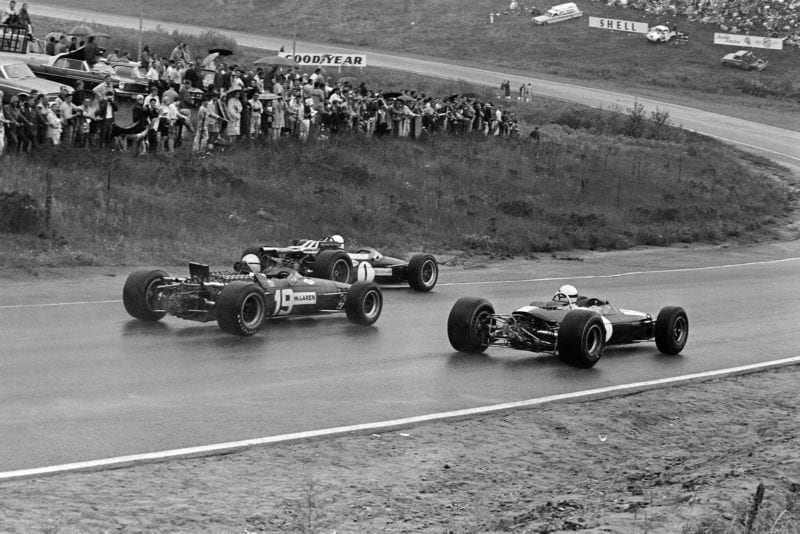
McLaren slices in between Brabham and Fisher after his early off
Motorsport Images
Whilst this excitement was going on at the front of the field, Pease had got started and was running last, many laps behind. Amon began to regain his confidence and got by the American tail-enders to pull up to 12th place by the 12th lap.
Bonnier got by Hobbs on lap 11, putting himself into 10th place. On lap 12 the BRMs were lying in numerical order, Stewart, Spence, Irwin, 6th, 7th and 8th positions, which they held until Stewart got by Hill, and Gurney overtook Irwin.
The rain eased and stopped after half an hour, and the lap times began to improve, but before the track dried out McLaren got by Clark and began to close on Hulme. Irwin spun on lap 18 and came into the pits with the throttle slides on one side filled with sand and mud, and he was retired. Pease spun off and spent many laps trying to restart; when eventually the engine dried out enough to start he was even more laps behind. Stewart, once he had passed Hill, took heart and caught and passed Brabham, and the two of them then closed right up on to Clark.
The track was now drying quickly and on about lap 25 the turning point came when all the power could be put on to the road. Clark, with Stewart and Brabham just behind, now began to gain on McLaren and on lap 27 they were just behind him, the four cars covered by one second and all lying 25 Seconds behind Hulme.
Next lap Clark was back into second place and he began to give the crowd a demonstration of driving at ten-tenths as he set off after the Brabham. On lap 32 the gap was down to 24 seconds. Two laps later it had closed to 21 seconds. McLaren tried to hang on but nothing could keep up with Clark as the track dried right out.
“Clark was back into second place and he began to give the crowd a demonstration of driving at ten-tenths as he set off after the Brabham”
Hulme had lapped Gurney just before it dried out, but the American unlapped himself and the two cars kept together for some time; in fact, until Hulme saw how the gap was closing when the pit signalled him to speed up. He passed Gurney and then, with the tail hanging well out, tried to stay ahead of Clark but, with Clark in the mood he was, nothing could hold him and on the 58th lap he shot by on the straight into the lead.
On the 58th lap, which was to end the dry period, for, fine rain began again, Brabham was third, having passed McLaren, now fourth. Ten laps previously McLaren’s engine was beginning to misfire due to a flattening battery and no alternator to recharge it. Fifth came Gurney, a lap behind, then Stewart and Hill, Spence, Amon, Hobbs, Bonnier, Attwood, Weitzes, Fisher and, many laps down, Pease completed the field.
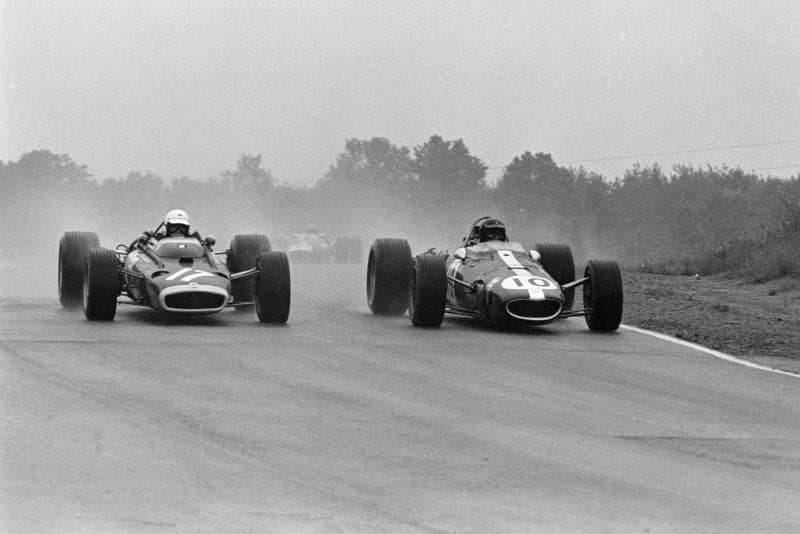
Gurney (right) overtakes Irwin
Motorsport Images
The rain now began to fall harder than ever and conditions reached their worst. Hobbs came to the pits on lap 6o and collected clean goggles. On lap 64 Stewart came in with grass and sand stuck in the intakes and rear suspension. After a quick clean-out he was sent off but next lap he was in again as the throttle linkage was jamming; after some more cleaning and another spring added, he was sent off again, but at the end of that lap he came in and climbed out, and the car was pushed away.
While Stewart was in and out of the pits, drama took place in the lead. The Brabhams had not caught up with Clark in this second storm and it looked as if the now lighter Lotus could retain first place. Hulme signalled that he was coming in for goggles and pulled into the pits next lap. At the same time Clark’s engine cut dead at the hairpin and Brabham suddenly found himself in first place. The Brabham pit was all excitement; Hulme went out with goggles and came in next lap for a dome-type visor.
The Lotus pit were still wondering what was wrong with Clark when Wietzes stopped on the outside of the pit wall with a dead engine. Mechanics pushed him to the end of the pits and when the electrics were dried out the engine started again, but only until they became wet again. For being pushed Weitzes was disqualified. After some 10 laps Clark re-appeared by the pits and next lap he came in with a dead engine which had cut on the straight when water again shorted out the ignition.
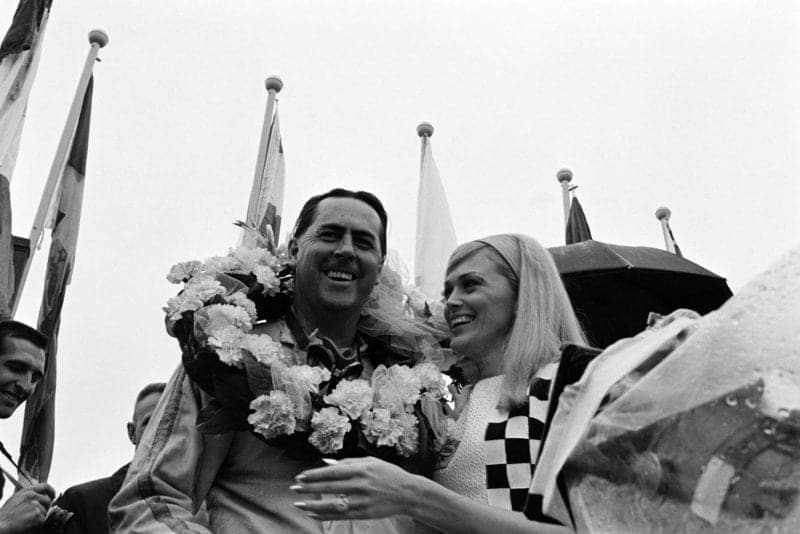
Brabham is congratulated on his win
Motorsport Images
This ended the drama. Gurney made two pit stops for goggles and mixture adjustment to give better performance at low revs, and the “Old Man” plodded on to win by 1min 1.9sec from his team-mate, who was in the only other car on the same lap.
“The most uncomfortable race to date this year and one in which the drivers really earned their money”
One lap behind was Gurney, then Hill another lap down. Spence and Anson completed 87 laps and McLaren 86 laps. The McLaren-BRM could have won the Canadian Grand Prix when the second lot of rain started, but the battery ran right down and another had to be fitted, which lost a lot of time.
Had an alternator been fitted the result may have been quite different. Clark did the fastest lap while catching Hulme with a time of a 1min 23.1sec (106.53mph), which equals Gurney’s time in the Lola T70.
The most uncomfortable race to date this year and one in which the drivers really earned their money.
